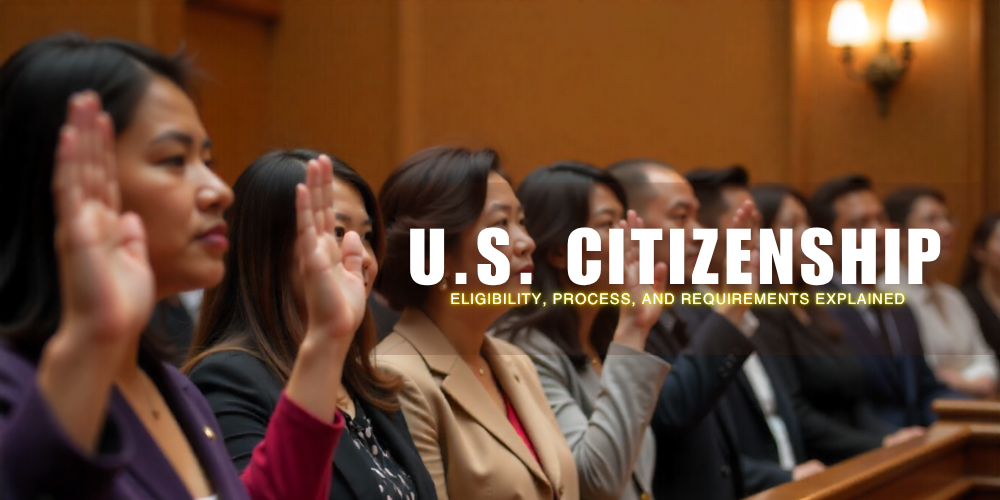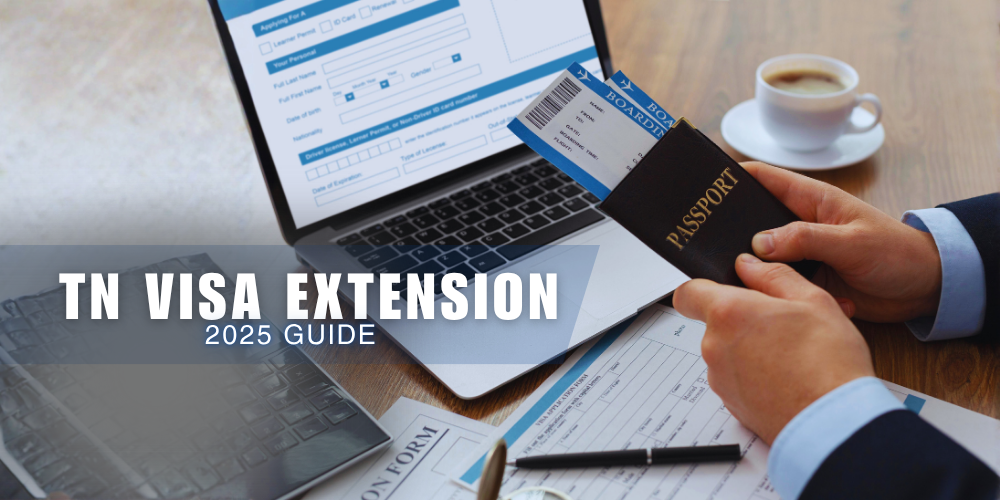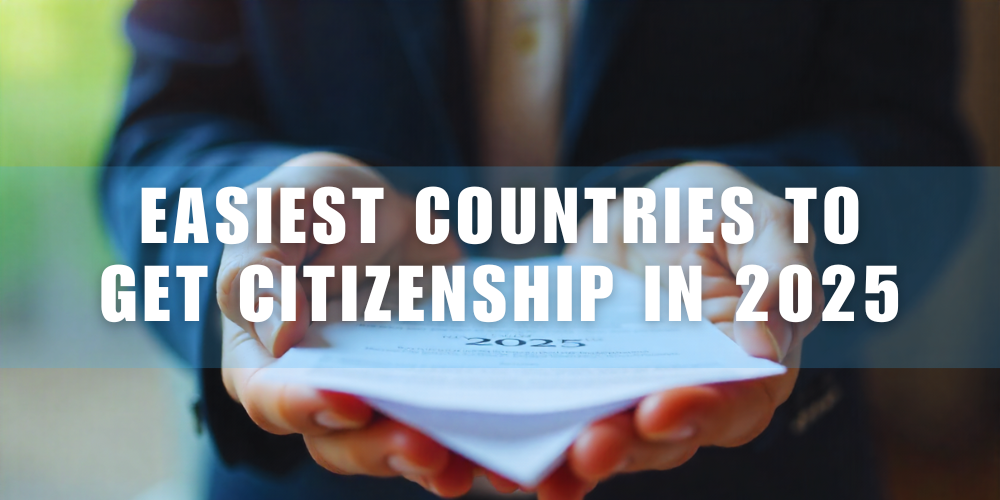--------- U.S. Citizenship Made Simple: Eligibility, Process, and Requirements Explained
Oct 4, 2025

For many, U.S. citizenship is more than just a passport—it’s a gateway to stability, opportunity, and a sense of belonging in one of the world’s most influential nations. Citizens gain the right to vote, the ability to run for public office, and access to the full spectrum of protections under U.S. law. Beyond rights, there’s also peace of mind: no more visa renewals, no looming residency deadlines, and the freedom to live abroad while keeping your place in America secure.
The most common route to citizenship is naturalization, a process designed for lawful permanent residents—green card holders—who want to make their bond with the United States official. It’s not overnight, nor is it automatic; it’s a carefully structured journey that ensures new citizens are prepared to participate fully in civic life.
By the end of this guide, you’ll have a step-by-step understanding of the eligibility requirements, the naturalization process, and what to expect along the way. In short: everything you need to turn the dream of U.S. citizenship into a reality.
Eligibility Requirements for U.S. Citizenship
Before filing paperwork or preparing for interviews, you’ll need to confirm that you actually qualify. U.S. immigration law sets clear eligibility benchmarks, ensuring that applicants are not only invested in America but also ready to shoulder the responsibilities of citizenship. Here are the key requirements:
Age Requirement
You must be at least 18 years old to apply, unless you’re serving in the U.S. military, where special rules may apply.
Permanent Residency Timeline
For most applicants, you’ll need to have held a green card for at least 5 years. If you’re married to a U.S. citizen, that requirement shortens to 3 years—a recognition of family unity as a pillar of immigration law.
Continuous Residence & Physical Presence
Citizenship isn’t just about paperwork—it’s about roots. You must show that you’ve lived continuously in the U.S. for 5 years (or 3 if married to a citizen) and have been physically present for at least half that time. Extended absences abroad could complicate your case.
State/District Residency
Applicants need to prove residency in the state or USCIS district where they’re filing. This ensures your application is processed by the right jurisdiction.
Good Moral Character
From criminal history to tax compliance, USCIS will review your background carefully. Demonstrating good moral character over the required period is crucial—issues like unpaid taxes or certain convictions can derail an application.
English and Civics Knowledge
Be prepared to demonstrate basic English skills (reading, writing, speaking) and pass a civics test on U.S. history and government. This isn’t just a formality—it’s a measure of your ability to integrate into American civic life.
Oath of Allegiance
Finally, you’ll need to take the Oath of Allegiance, pledging loyalty to the United States, its Constitution, and its laws. It’s the symbolic and legal moment that transforms an applicant into a citizen.
Step-by-Step Naturalization Process
Applying for U.S. citizenship may feel daunting, but when broken down, the process is straightforward. Think of it as a journey with five milestones—each one bringing you closer to becoming an American citizen.
Step 1: File Form N-400
Your starting point is Form N-400, Application for Naturalization. It can be filed online through the USCIS portal or mailed in paper form. Accuracy matters—double-check dates, addresses, and immigration history before submitting. Mistakes often mean delays or even denials. Pro tip: include every required document upfront and, if needed, certified translations of non-English records.
Step 2: Biometrics Appointment
Once your application is accepted, you’ll receive an appointment notice for biometrics. This involves fingerprints, photographs, and sometimes a signature—all used to run background and security checks. It’s routine but crucial; skipping it could halt your application.
Step 3: Interview & Citizenship Test
Next comes the USCIS interview, usually held at a local field office. A USCIS officer will review your application and test your English skills (reading, writing, speaking) and civics knowledge. The civics test covers U.S. history, government, and constitutional principles. Some applicants, such as older green card holders with long U.S. residency, may qualify for exemptions or simplified testing. Preparation is everything: flashcards, online practice tests, and even USCIS’s official study materials can make the difference.
Step 4: USCIS Decision
After the interview, USCIS will issue a decision. Your application can be:
- Approved – moving you to the final step.
- Continued – if more evidence is needed, or if you must retake part of the test.
- Denied – if eligibility requirements aren’t met or serious issues arise.
If denied, you may appeal or reapply depending on the reason.
Step 5: Oath Ceremony
The final milestone is the Oath of Allegiance ceremony. In this powerful moment, you pledge loyalty to the U.S. Constitution and laws, officially becoming a U.S. citizen. You’ll receive your Certificate of Naturalization—your proof of citizenship and your ticket to rights like voting and applying for a U.S. passport.
Special Considerations
While most applicants follow the same process, certain circumstances deserve special attention.
Military Pathways
Members of the U.S. armed forces may qualify for expedited or alternate naturalization routes. In some cases, residency requirements are waived, and the process is streamlined in recognition of military service. Families of service members may also have unique options.
Delays & Backlogs
As of 2025, stricter background checks have extended USCIS processing times. What once took around a year may now stretch longer, depending on your local field office’s caseload. Staying patient—and staying on top of USCIS updates—is part of the process.
Documentation Tips
Paperwork is often the difference between a smooth application and a stalled one. Ensure all documents are complete, accurate, and—if not in English—accompanied by certified translations. Tax returns, proof of residence, and green card copies should be organized and easy to submit. Think of it as building a case file that tells USCIS: “I am ready to become a citizen.”
The Average Timeline for U.S. Citizenship
On average, it takes about 5.5 months to go from submitting your Form N-400 (Application for Naturalization) to attending the oath ceremony where you officially become a U.S. citizen. This includes biometrics, the interview, testing, and scheduling the ceremony itself.
But the timeline isn’t identical for everyone:
- Variation by Location: USCIS field offices across the country handle different volumes of applications. A smaller office in one state may process cases more quickly than a busier urban hub handling thousands of applicants.
- Realistic Range: While 5.5 months is the average, some applicants finish the process faster, while others wait longer—especially if additional background checks or document requests are triggered.
The takeaway? The naturalization process is reasonably swift compared to many immigration procedures, but it’s wise to prepare for flexibility.
Costs of Applying for Citizenship
As of 2025, the U.S. citizenship application isn’t just about time—it also comes with a financial cost.
- $710 if you apply online.
- $760 if you file a paper application.
For some, those fees can feel like a barrier. Thankfully, there are exceptions and relief options:
- Military Applicants: Members of the U.S. Armed Forces can apply at no cost, a recognition of their service.
- Fee Waivers & Reductions: Applicants facing financial hardship may request help by filing Form I-912. If approved, this can reduce or eliminate the fee entirely.
Citizenship comes with priceless benefits—voting, a U.S. passport, and the ability to petition family members—but it’s important to plan for the upfront costs as part of your journey.
After You Become a U.S. Citizen
Becoming a U.S. citizen is more than just a legal change; it’s a transformation in rights, opportunities, and responsibilities. Here’s what awaits on the other side of the oath:
Key Benefits
- Voting Power: Only U.S. citizens can vote in federal elections. Your voice shapes the future of your community and country.
- U.S. Passport: A powerful passport that opens doors to visa-free travel in many countries and guarantees protection abroad.
- Family Petitions: Citizens can sponsor more categories of family members for green cards, speeding up reunification.
Responsibilities
With rights come duties. As a citizen, you’ll be expected to:
- Serve on a Jury when called, a cornerstone of the justice system.
- Pay Taxes consistently and fully, maintaining your civic obligations.
- Honor the Oath you swore—loyalty to the Constitution and active participation in American civic life.
FAQs & Common Challenges
Is it hard to pass the civics test?
The civics test isn’t designed to be a barrier—it’s a measure of your preparedness. With 100 possible questions (and only 10 asked), most applicants pass, especially if they study with USCIS flashcards or practice apps. Preparation and repetition make it manageable.
How long does the whole process usually take?
Timelines vary by region and USCIS workload. On average, the process can take 12–18 months, though post-2025 background check changes have stretched wait times. Applying early and keeping your documents in order can help minimize delays.
What happens if my application is denied?
A denial isn’t necessarily the end of the road. In many cases, applicants can appeal, request a hearing, or reapply after addressing the issues that caused the refusal. Immigration attorneys often help navigate these situations effectively.
Conclusion
Becoming a U.S. citizen is not just a box to tick—it’s a life milestone. Yes, the paperwork can feel overwhelming and the wait frustrating, but every step brings you closer to full participation in American civic life. With preparation, patience, and perseverance, the journey is absolutely achievable.
If you’ve been wondering how to take the leap, the answer is clear: check your eligibility, gather your documents, and begin the process. The path to citizenship is paved with effort, but the reward—belonging, opportunity, and voice—is worth every step.
Recent Articles

Visa Number for ESTA: Everything You Need to Know Before You Fly
If you’ve ever tried to check in online for a U.S.-bound flight and been met with that dreaded box

I-94 Record Guide 2025: How to Get, Retrieve, and Fix Your Arrival/Departure Record
If U.S. immigration were a novel, the I-94 would be the quiet supporting character who turns out to

H-1B to H-4 Change of Status: The Complete 2025 Guide (Processing Times, Requirements & EAD Eligibility)
Transitioning from H-1B to H-4 status isn’t just a bureaucratic shuffle—it’s a strategic shift

How Long Does a TN Visa Extension Take in 2025?
Time — it’s the one thing every TN professional learns to respect. Whether you’re an engi

The Easiest Countries to Get Citizenship in 2025: Fast Tracks, Smart Moves, and Hidden Shortcuts
In 2025, the idea of belonging to just one nation feels almost quaint. As the world continues to shr

U.S. Citizenship Made Simple: Eligibility, Process, and Requirements Explained
For many, U.S. citizenship is more than just a passport—it’s a gateway to stability, opportunity
Read More

Visa Number for ESTA: Everything You Need to Know Before You Fly

I-94 Record Guide 2025: How to Get, Retrieve, and Fix Your Arrival/Departure Record

H-1B to H-4 Change of Status: The Complete 2025 Guide (Processing Times, Requirements & EAD Eligibility)

How Long Does a TN Visa Extension Take in 2025?

The Easiest Countries to Get Citizenship in 2025: Fast Tracks, Smart Moves, and Hidden Shortcuts

U.S. Citizenship Made Simple: Eligibility, Process, and Requirements Explained

Welcome to the VisaTravel blog. We know that navigating the maze of visa applications and online forms can be as tricky as choosing the perfect travel playlist (which is all we want you worrying about anyway).
Throughout our years of experience, though, we’ve uncovered a mountain of knowledge which, via this blog, we’re sharing with you! Whether you're diving into the world of travel visas, wondering about the ESTA online hustle, or just trying to figure out the DS160 form, think of us as your online concierge, here to make the process easy and most of all, clear.
At this point in our global context, who has time for endless paperwork and confusing legal jargon? No one. That's why we're all about spilling the tea on online visa hacks, easier-to-work-with DS160 forms, and giving you tips on everything from tourist visas to immigration, to that last-minute ESTA online adventure.
So, just plug in a word you’re curious about on the search bar, and boom. We've got the tips, tricks, and insider info to help you (and anyone else you may be traveling with) get to your travel destination with the confidence of a seasoned traveler.
Now go explore!
 U.S. Visa
U.S. Visa
 Canada eTA
Canada eTA
 Schengen Visa
Schengen Visa
 New Zealand eTA
New Zealand eTA
 United Kingdom eTA
United Kingdom eTA
 Australia eVisitor
Australia eVisitor
 Vietnam eVisa
Vietnam eVisa
 Egypt eVisa
Egypt eVisa
 Singapore Arrival Card
Singapore Arrival Card
 Sri Lanka eVisa
Sri Lanka eVisa




